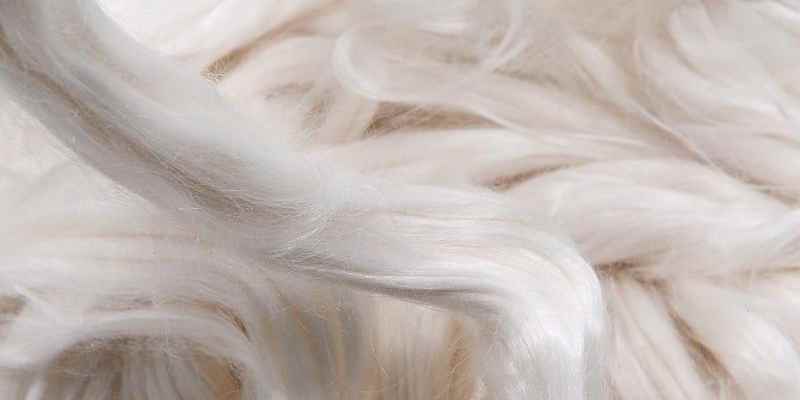As the search for more sustainable fabrics sweeps the fashion industry, you’ve probably seen brands promote their use of TENCEL fabric. You may have noticed it on labels of your favorite eco-friendly items. But what is TENCEL exactly and why is it claimed to be greener?
In this article, we explain all the essential details of TENCEL fabric and why top brands – including Eileen Fisher, Patagonia, and H&M – are making it a top eco-fabric of choice.
What is TENCEL?
TENCEL is a brand name for the semi-synthetic fibers made by Austrian textile company Lenzing AG.
Lenzing offers numerous TENCEL products, such as lyocell, modal, micro modal, with the mission to improve the industry by leading the way in transparency and developing sustainable technologies.
TENCEL that is referred to most often is TENCEL lyocell, with the generic name of the fiber being lyocell. TENCEL lyocell was invented to replace rayon/viscose, whose production is energy-intensive and pollutive, and as a cheaper alternative to silk, yet just as soft and drape-like.
TENCEL lyocell is called third generation rayon/viscose, and TENCEL modal is called second generation rayon/viscose.
TENCEL lyocell and modal are more similar than different, with the difference mainly lying in modal being just that much more soft and silk-like since it is sourced from beechwood trees. TENCEL lyocell is made from wood cellulose of eucalyptus trees. It is not entirely synthetic, like petroleum-based fibers nylon and rayon, nor is it entirely natural, like cotton or silk.
A range of products include TENCEL now (such as bedding, general apparel, outerwear, active wear, denim, intimate, and footwear). It is more durable than cotton and linen, even when wet.
What about the price? TENCEL can be on the expensive side because it costs more to produce, but in the long run, TENCEL retains color, shape, and drape, and many products do not even require dry-cleaning.
Pros and Cons of TENCEL
A main reason for TENCEL’s popularity is not only being one of the most eco-friendly options. Rather, its softness and comfort is desirable and makes TENCEL a great alternative to cotton and silk.
Pros
- Soft and comfy
- Drape quality
- Moisture wicking, thin, breathable, and great for keeping cool
- Naturally anti-bacterial
- Biodegradable
- High durability and can withstand washes
- Less wrinkling and fading
- Shrink only 3% on first washing and then no shrinkage
Cons:
- Higher price than cotton
- Tendency to pill
- May irritate sensitive skin because some manufacturers use chemicals to dye lyocell
- TENCEL lyocell must be combined with other materials to avoid shrinkage and/or enhance qualities
RELATED: 20 Best Sustainable Swimwear Brands for an Eco-Friendly Summer
Is TENCEL Sustainable?
Botanic Source
Lyocell, under the brand name TENCEL, is the most eco-friendly option. Why? TENCEL lyocell is often harvested from eucalyptus trees, which is a highly durable plant, therefore requiring no pesticides and little water to grow with fast regrowth and regeneration.
This compares to generic lyocell that is harvested from oak or birch trees, most likely without strict sustainability policies. Products must include at least 30% Lenzing fibers to be labeled with the TENCEL trademark and Lenzing TENCEL certification.
The botanic origin allows TENCEL to be biodegradable. Furthermore, Lenzing is committed to sourcing wood from sustainably certified forests, such as FSC and PEFC standards.
Closed Loop Production
Perhaps the best feature of TENCEL production is its closed loop system.
Once wood chips are obtained, they are soaked in a non-toxic solvent and does not include bleach or chlorine, placing it above many other fabrics considering chemical usage. Then, over 99% of the water and solvent is recycled and reused, minimizing waste and water usage. IT
Energy Efficiency
Lenzing’s pulp factories use renewable energy and are self-sufficient by taking the remaining biomass after pulp production and turning it into bioenergy that is used for fiber production and connects to the national grid.
Furthermore, all parts of the wood are used. For example, in addition to bioenergy, leftover products are supplied to the food industry, since acetic acid can be used to pickle vegetables and xylose functions as a low calories substitute.
Certifications
TENCEL has received numerous certifications for their low environmental impact, such as the European Award for the Environment, EU Ecolabel, and USDA certified biobased product.
Top Brands Using TENCEL
Interested in trying out this innovative material? Here are some top sustainable brands that are using TENCEL fabric in some of their collections.
- Patagonia
- Aritzia
- H&M
- Reformation
- Madewell
- Victoria’s Secret
- AllBirds
- Amour Vert
- GUESS
- MATE the Label
- Thread & Supply
- ASOS
- Athleta
- Hanes
- Ted Baker
- Lucky Brand
- PotteryBarn
Bottom Line
With TENCEL’s low environmental impact and soft quality, it checks out as a great sustainable fabric. Although TENCEL is more expensive than cotton (yet cheaper than silk), the investment pays off in the long run with higher durability and a more eco-conscious closet.

